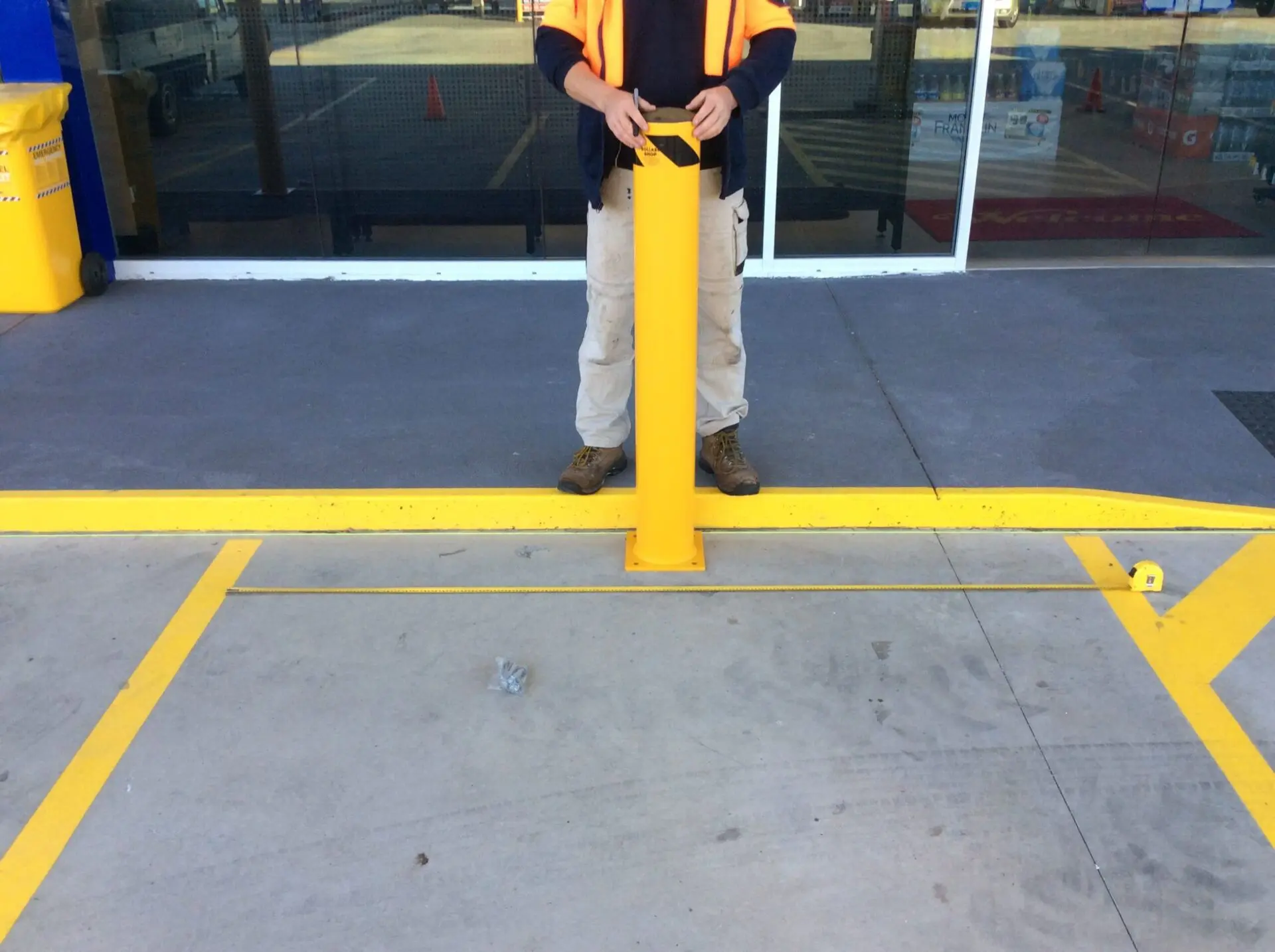Concrete bollards are an integral safety feature, designed to ward off vehicular accidents and deter any attempt at ram-raiding. They’re often employed as safeguards in pedestrian zones or to restrict vehicle access in parking areas.
Crashproof bollards can also be found at parks, stadiums and campuses to control traffic flow and limit access. These crash rated bollards provide reliable protection from impact in any area where protection is needed.
Durability
A concrete bollard may look sturdy enough, but its durability ultimately depends on how well it was designed and installed. To start, ensure the surface on which it will be located is clean and free from hazards such as pipes or gas lines – using a broom, pressure washer or vacuum pump can help with this task. A bollard installer must also check that the area is dry as any remaining moisture could swell and distort its base, possibly jeopardizing its integrity and cause it to shift out of position during installation.
Other factors also contribute to the longevity of a concrete bollard, including what kind of vehicle collision it will withstand and its anticipated speed (80kph is considered the benchmark for quality bollards). A top-quality bollard should ideally withstand such impacts and remain standing.
Bollards often are submerged under concrete to enhance their stability, but this may compromise their ability to absorb impacts. Concrete doesn’t flex like flexible materials like steel core bollards do and thus doesn’t disperse energy as effectively when an impact hits. A flexible steel core helps deflect collisions away from people and equipment by deflecting collision energy back towards its source and redirecting collisions elsewhere.
To ensure the protection provided by a bollard can last as long as possible, regular maintenance is also a necessity. Visual inspection should take place regularly to detect any signs of damage or deterioration and address them promptly. A regular yearly check is ideal; however more frequent inspections should take place when operating in harsher environments or when conditions change suddenly.
Bollards with moving parts should be given regular applications of all-purpose lubricant to keep them operating smoothly and increase their lifespan. Applying all-purpose lubricants also allows them to retract and extend easily as well as respond more rapidly to control commands from their controllers.
If the goal of your concrete bollard is to serve as a visual barrier, coating it with an abrasion-resistant and fade-proof paint will help it withstand environmental elements and shorten recovery times following knocks or scrapes. When selecting paint colors to complement both its environment and surroundings – such as nearby structures – and any signage/signage, powder coat is often the superior choice for highly visible bollards.
Impact Resistance
Bollards are used to physically separate vehicles from pedestrians, buildings or other property. Additionally, they act as visual guides that direct traffic flow in warehouses, parking garages and city streets. With such a diverse selection of materials and shapes to choose from, it’s crucial that the appropriate bollard is chosen for any specific application.
Concrete bollards are ideal for high traffic areas due to their durability and strength; however, cold climates may increase corrosion risks; galvanising or powder coating can reduce this vulnerability; but concrete bollards still require regular maintenance to stay in good condition.
Steel bollards provide greater impact resistance than concrete alternatives, making them better-suited for use across a range of applications. Common uses for steel rising bollards include stadiums and event venues where removable bollards can be raised or lowered as necessary during high-attendance events; business premises and residential driveways benefit from rising bollards that can be locked in place or lowered to allow only approved employee vehicles through while keeping unauthorised cars out.
Design of bollards is key to providing effective impact resistance. Round HSS members compliant with ASTM A1085 offer higher CVN impact ratings than square sections, making them the go-to option for concrete-filled bollards. Soft impact designs may meet Eurocode 1 requirements allowing the material to deform under vehicle impact rather than crushing and shattering under its pressure.
Certain concrete bollards can be customized for an attractive appearance, and some models even tilt or spin upon impact to reduce damage and avoid accidents. One such bollard, known as the Deflector Post, tilts, spins, and lifts upon impact to shield against glancing blows; it helps lower injuries among employees as well as vehicles while cutting costs associated with repairs or replacements.
Aesthetics
Concrete bollards add a beautiful element to urban landscapes, seamlessly blending in with surrounding architecture and infrastructure. Their uniform appearance provides a sense of order while serving practical functions, like marking off pedestrian zones or restricting vehicle access. Furthermore, bollards come in an assortment of colors and materials making them suitable for nearly every aesthetic imaginable – grey concrete bollards offer a more subtle appearance that blends in well with green spaces while stainless steel models boast modern, sleek appearances that stand out beautifully among contemporary settings.
Concrete bollards not only add visual appeal, but they are also invaluable defense mechanisms against terrorist acts or vehicle attacks. Military bases, government buildings and other high-risk sites can benefit greatly from using bollards to limit vehicle access; this decreases the chance of fast moving cars ramming into them and potentially inflicting damage.
Concrete bollards can also be installed to divide walkways from vehicular traffic in commercial and residential streets, providing a safer way for people to navigate busy areas. Furthermore, these sturdy yet aesthetically-pleasing structures help define areas reserved for pedestrian use such as outside restaurants, hotels, offices or other commercial facilities.
decorative concrete bollards with fluted designs are another popular option for creating an eye-catching aesthetic in their public spaces and outdoor areas. These decorative bollards often see heavy foot traffic such as in public parks or other outdoor spaces and they can be painted to blend in seamlessly.
Concrete bollards provide an efficient solution for various applications, but even they cannot avoid occasional impacts without incurring some dents and scratches. Unfortunately, even minor damages such as these can compromise its effectiveness if left unattended; by taking proactive steps when they do arise it’s possible to keep your bollards looking their best while performing at maximum capacity. With some simple maintenance tips you can keep your bollards in their prime state and performing as designed.
Maintenance
Bollards should be regularly cleaned and inspected to ensure they are performing their function optimally. This inspection includes looking for signs of damage such as surface abrasions, cracking or structural deterioration as well as making sure locking mechanisms work as they should. In some instances, bollards may require repainting to reduce corrosion while improving aesthetics – damaged or poorly maintained bollards become ineffective at guiding pedestrians or restricting vehicle access, creating the perception that the site is neglected or unattended.
No matter what material a bollard is made from, environmental conditions will take their toll over time. Barriers situated near coasts may be exposed to saltwater spray; high traffic areas can result in debris build-up on surfaces resulting in wear and tear; in some instances even the locking mechanisms may deteriorate with time.
Regular inspections will help identify issues before they become more significant issues. For instance, if the locking system on a retractable bollard becomes sticky and difficult to operate, visual inspection may identify this and allow repairs before permanent damage occurs. Furthermore, dirty or scratched concrete bollards can easily be touched up so they look brand new reducing overall costs while increasing attractiveness on site.
Keep a record of inspection, cleaning, and maintenance activities to reduce ambiguity and miscommunication, potentially saving both time and money in the future. This may reduce ambiguity while saving both resources – both time and money!
Specialty shaped bollards, such as those resembling balls or globes, add an eye-catching element to any security system while still fulfilling their function of restricting vehicle access and guiding pedestrians. These bollards can enhance curb appeal of both commercial and residential properties by serving both their purpose of restricting vehicle entry while simultaneously adding to it with their visual aesthetic and come in various sizes, finishes and textures to fit into any environment or location.

